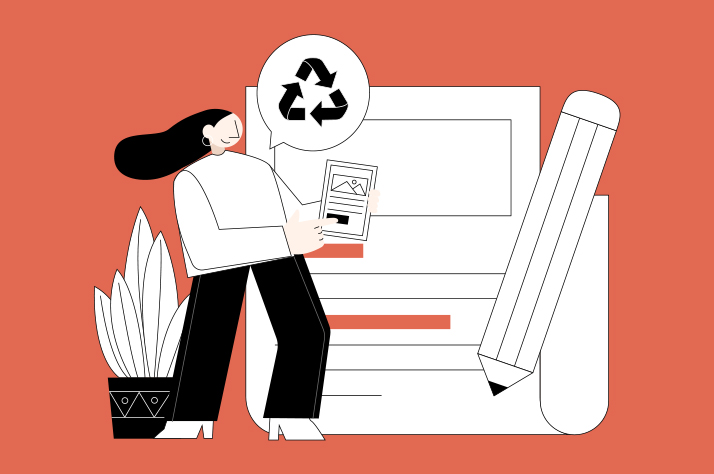Getting better content mileage: The 3Rs of recycling content
- Home
- Blogs

Creating content can be anything from a labour of love to a chore that drains time and resources.
Wherever you sit on that spectrum, it’s fair to say that content creation is an in-depth, time-consuming process that involves a lot of research and experimentation.
With that in mind, recycling content emerges as an excellent way to get more mileage out of your creative output.
What is content recycling?
There are many different ways to redistribute your content once you’ve published it. Doing this can give your content a longer life, refresh it, or give it another chance if it didn’t work as well as you’d hoped the first time around.
Being repetitive, albeit with a slight twist for each new iteration, is also an essential part of building a recognisable brand and digital presence. It makes your brand more ‘sticky’, inviting users to remain engaged with your content and to return to it in the future.
As there are so many media channels and platforms to choose from, you need to push your content for it to get to your target audience. It’s not enough to simply publish it. Brands should utilise various platforms to ensure they stay competitive and grow their influence.
This is where the 3Rs of recycling content become incredibly useful…The 3Rs of recycling content
Republishing
If the relevance and value of your content haven’t changed, but its performance is starting to slip, you can simply republish it with a few tweaks so it makes its way back to your audience.
This is common with blog content where the topic may be evergreen, but engagement has dipped. To get the content back into circulation, republish it and change details like the social media post, the title or the image. This makes sure your feed still looks fresh.
How to do it:
- Update the imagery or add more photos, icons or infographics
- Review the metadata
- Add additional content, up-to-date information or make general edits
- Include links to new content or CTA’s
When to do it:
- Traffic is low, and rankings are dropping or nonexistent
- The content is broadly relevant, but certain elements are out of date
- The original publish date is more than a year ago
- The content is not converting
Are you interested in building a more robust content plan for your organisation? Get in touch with us today!
Repackaging
By combining your existing content with other relevant information on the topic or changing the framing, you can create a new piece of content pitched to a different audience. A common example of this is creating a blog post that repositions the original content in a new light or combines it with content from a second blog.
How to do it:
- Combine two different blogs with overlapping content into a new piece of content
- Combine a few pieces of content to create a new blog (or update an old one)
When to do it:
- There is a lot of overlapping content
- Your site’s information architecture (IA) doesn’t make sense, and/or information is being repeated
- Important information lives in different places and is scattered
- The content is good but may resonate better with a different audience
Repurposing
Generally speaking, repackaging content involves taking your existing long-form content pieces (blog posts, e-books etc.) and breaking them down into smaller pieces of content. Examples of this would be using carousel posts on Instagram or LinkedIn to summarise the key points of the original content, or using it to create a script for a short Reel or TikTok post.
The emergence of generative AI presents an excellent opportunity on this front. Taking the example of repurposing a blog as a LinkedIn carousel, you could feed the original blog to an AI chatbot like ChatGPT and prompt it to create drafts of copy for five carousel slides that address the key points of the blog. From here you can deliver further prompts to adjust the content and then polish up the final copy with human eyes.
How to do it:
- Blog post to video/webinar
- Series of blog posts to eBook
- Sales email to blog post
- Blog post to social media content
When to do it:
- Good content exists but there is no strategic distribution plan
- A blog has been created but nothing has been done after publishing it on the website
- To leverage success of successful content
- There are multiple audiences with differing online habits
- Content is underperforming in its current format but could perform better in another
What about design?
While recycling content is a cost-effective and efficient way to get the most out of your creative energy, one stopping point for marketing professionals tends to be the design element.
If you work in this field, you’ve likely found yourself in a position where you can see an opportunity to repurpose blog content as an infographic or image carousel, but just don’t feel confident enough to create the design yourself in case you use brand assets incorrectly.
This is a valid concern and one we empathise with. That’s why we’ve created a product that can streamline your design efforts and eliminate creative road blocks.
Canva Brand Toolkit
By partnering with Canva and creating the Canva Brand Toolkit, we’ve made it easy for non-graphic designers to create branded collateral in minutes!
The cornerstone of the Toolkit is templates. Our designers build custom branded templates in Canva so that you can easily create new content in minutes without fear of breaching your brand guidelines.
Are you ready to bring design into the marketing domain?
Speak to us about Canva today!